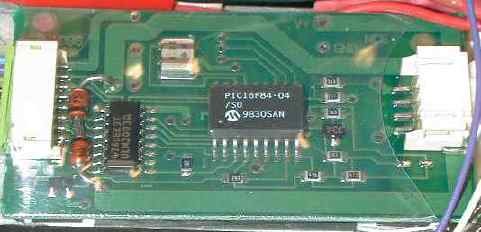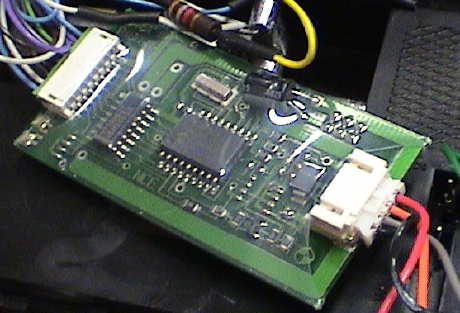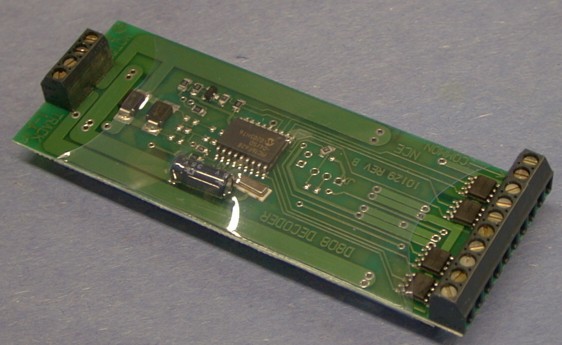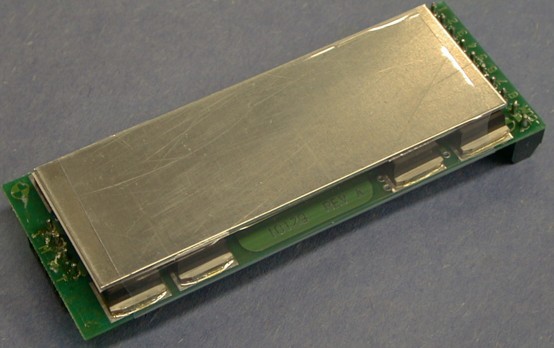North Coast Engineering
(NCE) has been making high end DCC systems for a long time. When I
became disgusted with the Digitrax DG580L I went looking for another
manufacturer of high current decoders. I found NCE.
NCE's decoders have one attribute that I find extremely valuable,
they are tough as nails. Some of them were lacking on frills, but the
main purpose of a DCC decoder is to drive a motor and the NCE decoders
do that extremely well. In my experience, they are stone reliable.
I've used, and still use, 3 varieties of NCE decoder, the D408,
D408SR and D808SR. NCE's numbering system is pretty easy to figure out.
They all start with a "D", the next digit is the average current
capability and the next two digits are the number of functions. The
"SR" at the end indicates silent running.
Virtually all of information that is on this page can be found in
other places on this site, but I am using this page to collect that
widely spread information in one place.
Contents
 North Coast Engineering made a
decoder, the D408, that had the highest average current capability of
any of the large scale decoders at that time. NCE uses Schottky barrier
rectifiers to reduce the voltage drop and therefore the heat generated
by the rectifier. I bought two D408's for use in the RS-3's that had
smoked some Digitrax decoders. They both handle the RS-3's at maximum
load with no sweat. Even though the PWM frequency is low, there is
little acoustic motor noise. It runs perceptibly warm pulling 15 cars
on a grade. The D408 is a workhorse, but it isn't packed with accessory
features. There is no reversing headlight. Analog conversion of the
D408 is marginal at best. It runs, but it only goes in reverse no
matter what the track polarity is and it has no ability to set function
output states when analog converted. The NCE decoder will operate in
128 speed step mode, but then the acceleration and deceleration rates
don't work so I run them at 28 speed steps.
North Coast Engineering made a
decoder, the D408, that had the highest average current capability of
any of the large scale decoders at that time. NCE uses Schottky barrier
rectifiers to reduce the voltage drop and therefore the heat generated
by the rectifier. I bought two D408's for use in the RS-3's that had
smoked some Digitrax decoders. They both handle the RS-3's at maximum
load with no sweat. Even though the PWM frequency is low, there is
little acoustic motor noise. It runs perceptibly warm pulling 15 cars
on a grade. The D408 is a workhorse, but it isn't packed with accessory
features. There is no reversing headlight. Analog conversion of the
D408 is marginal at best. It runs, but it only goes in reverse no
matter what the track polarity is and it has no ability to set function
output states when analog converted. The NCE decoder will operate in
128 speed step mode, but then the acceleration and deceleration rates
don't work so I run them at 28 speed steps.
Overall I am very happy with these decoders and even though they are
long of tooth, I have no intention of upgrading them.
D408 Installations
| Locomotive |
Link |
Notes |
| Aristo RS3 |
RS3 Tips |
They make a little motor noise, but not enough to be bothersome.
Very reliable decoders, they haven't been touched in 10 years. |
 The latest D408SR decoders are silent running (16 kHz
switching frequency) and seem to have all of the high current
capability of its predecessor. It has 15 special lighting features
available on all function outputs. It also has a reversing headlight.
Analog conversion now works. The acceleration and deceleration rates
now work in 128 speed step mode as does the Vmax, Vmid and Vmin
settings. The decoder can also interpret a speed table in 128 step
mode. The D408SR is very good but it does not have BEMF.
The latest D408SR decoders are silent running (16 kHz
switching frequency) and seem to have all of the high current
capability of its predecessor. It has 15 special lighting features
available on all function outputs. It also has a reversing headlight.
Analog conversion now works. The acceleration and deceleration rates
now work in 128 speed step mode as does the Vmax, Vmid and Vmin
settings. The decoder can also interpret a speed table in 128 step
mode. The D408SR is very good but it does not have BEMF.
The D408SR looks very similar to the older D408 but there are some
visible differences.
There is a newer D408, the D408-E. I don't have one of these, but it
does have BEMF motor control and is the same size as the D408SR.
D408SR Installations
| Locomotive |
Link |
Notes |
| Aristo Pacific (old version) |
Pacific Tips |
This decoder was the first one that actually worked properly in the
Pacific. The Pacific is undermotored and needed all the power it could
get to run properly. However, when the motor heated up and lost some
torque, it would lug down. This really wasn't the fault of the decoder.
The decoder worked well for years but was replaced by a D808 as an
experiment. |
| Aristo Doodlebug |
Aristo Doodlebug Tips
|
Works fine |
| Aristo SD45 |
SD45 Tips |
Works fine |
| Lehmann Porter |
Lehmann Porter
Tips |
Works fine |
 In September 2002, NCE
released a much heftier decoder than the D408SR. The new one is the
D808SR. It is essentially the same decoder as the D408, just with a
bigger heat sink and much bigger components. It is silent running at
15.625 kHz, however like the D408SR It does not have back-EMF motor
control. There are 8 function outputs with 0.5 amp continuos and 2 amp
surge capability on each output. Each function output can take one of
15 attributes such as a ditch light simulation.
In September 2002, NCE
released a much heftier decoder than the D408SR. The new one is the
D808SR. It is essentially the same decoder as the D408, just with a
bigger heat sink and much bigger components. It is silent running at
15.625 kHz, however like the D408SR It does not have back-EMF motor
control. There are 8 function outputs with 0.5 amp continuos and 2 amp
surge capability on each output. Each function output can take one of
15 attributes such as a ditch light simulation.
 The entire backside of the
D808 is consumed by a metal heat sink. Under the heat sink are four 48
amp Schottky barrier rectifiers and four very large FET switches rated
at 31 amps or better.
The entire backside of the
D808 is consumed by a metal heat sink. Under the heat sink are four 48
amp Schottky barrier rectifiers and four very large FET switches rated
at 31 amps or better.
There is really only reason for the existence of this decoder. USA
Trains uses insanely high current motors in some or all of their Diesel
locomotives. I had a GP9 for over 4 years before NCE came out with this
decoder specifically designed to go into those locos. As soon as the
D808SR was available, I bought one for the GP9. It has worked fine ever
since.
I also put one in an old Aristo Pacific that tended to lug a little. The thought that the D808SR might have lower voltage drop a high current than the D408SR (which is pretty low in its own right). The D808 ran the loco better when the motor was cold indicating that the D408SR might have been straining a little, but when the motor heated up and it's resistance increased a little, the D808SR did no better than the D408SR. A high capability decoder really cannot help a loco that doesn't have the basic motor capability to do it's job properly.
D808 Installations
| Locomotive |
Link |
Notes |
| USAT GP9 |
GP9 Tips |
The decoder worked in the GP9 and has withstood full stall
conditions which are VERY severe in this loco. |
| Aristo Pacific (old style) |
Aristo Pacific Tips |
Was better than the D408SR that it replaced until the motor heated
up, then it ran about the same. |
| USAT F3A |
USAT F3A Tips |
No issues. |
This page has been accessed  times since 3 Dec 08.
times since 3 Dec 08.
© 2008-2011 George Schreyer
Created 3 Dec 08
Last Updated October 22, 2011
 North Coast Engineering made a
decoder, the D408, that had the highest average current capability of
any of the large scale decoders at that time. NCE uses Schottky barrier
rectifiers to reduce the voltage drop and therefore the heat generated
by the rectifier. I bought two D408's for use in the RS-3's that had
smoked some Digitrax decoders. They both handle the RS-3's at maximum
load with no sweat. Even though the PWM frequency is low, there is
little acoustic motor noise. It runs perceptibly warm pulling 15 cars
on a grade. The D408 is a workhorse, but it isn't packed with accessory
features. There is no reversing headlight. Analog conversion of the
D408 is marginal at best. It runs, but it only goes in reverse no
matter what the track polarity is and it has no ability to set function
output states when analog converted. The NCE decoder will operate in
128 speed step mode, but then the acceleration and deceleration rates
don't work so I run them at 28 speed steps.
North Coast Engineering made a
decoder, the D408, that had the highest average current capability of
any of the large scale decoders at that time. NCE uses Schottky barrier
rectifiers to reduce the voltage drop and therefore the heat generated
by the rectifier. I bought two D408's for use in the RS-3's that had
smoked some Digitrax decoders. They both handle the RS-3's at maximum
load with no sweat. Even though the PWM frequency is low, there is
little acoustic motor noise. It runs perceptibly warm pulling 15 cars
on a grade. The D408 is a workhorse, but it isn't packed with accessory
features. There is no reversing headlight. Analog conversion of the
D408 is marginal at best. It runs, but it only goes in reverse no
matter what the track polarity is and it has no ability to set function
output states when analog converted. The NCE decoder will operate in
128 speed step mode, but then the acceleration and deceleration rates
don't work so I run them at 28 speed steps. The latest D408SR decoders are silent running (16 kHz
switching frequency) and seem to have all of the high current
capability of its predecessor. It has 15 special lighting features
available on all function outputs. It also has a reversing headlight.
Analog conversion now works. The acceleration and deceleration rates
now work in 128 speed step mode as does the Vmax, Vmid and Vmin
settings. The decoder can also interpret a speed table in 128 step
mode. The D408SR is very good but it does not have BEMF.
The latest D408SR decoders are silent running (16 kHz
switching frequency) and seem to have all of the high current
capability of its predecessor. It has 15 special lighting features
available on all function outputs. It also has a reversing headlight.
Analog conversion now works. The acceleration and deceleration rates
now work in 128 speed step mode as does the Vmax, Vmid and Vmin
settings. The decoder can also interpret a speed table in 128 step
mode. The D408SR is very good but it does not have BEMF. In September 2002, NCE
released a much heftier decoder than the D408SR. The new one is the
D808SR. It is essentially the same decoder as the D408, just with a
bigger heat sink and much bigger components. It is silent running at
15.625 kHz, however like the D408SR It does not have back-EMF motor
control. There are 8 function outputs with 0.5 amp continuos and 2 amp
surge capability on each output. Each function output can take one of
15 attributes such as a ditch light simulation.
In September 2002, NCE
released a much heftier decoder than the D408SR. The new one is the
D808SR. It is essentially the same decoder as the D408, just with a
bigger heat sink and much bigger components. It is silent running at
15.625 kHz, however like the D408SR It does not have back-EMF motor
control. There are 8 function outputs with 0.5 amp continuos and 2 amp
surge capability on each output. Each function output can take one of
15 attributes such as a ditch light simulation. The entire backside of the
D808 is consumed by a metal heat sink. Under the heat sink are four 48
amp Schottky barrier rectifiers and four very large FET switches rated
at 31 amps or better.
The entire backside of the
D808 is consumed by a metal heat sink. Under the heat sink are four 48
amp Schottky barrier rectifiers and four very large FET switches rated
at 31 amps or better.